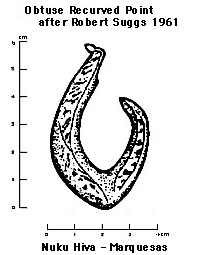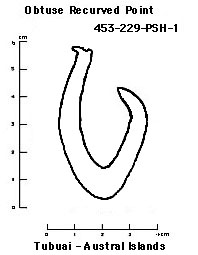

back *****************VOLUME 17 page 8 ***************** next page
Obtuse Recurved Point
*****This group was originally identified by Suggs (1961, Fig. 26,h,o) who illustrated two somewhat different specimens without explaining the range of variability among fishhooks included in this category. As defined here, some specimens in this group are very similar in form to the Rotating hooks, distinguished only by their inwardly angled point tip, while others have an angled bend. The shank forms vary from incurved to straight. The point tip is always angled upwards, in contrast to those of the Acute Recurved Point hooks which are angled slightly down.
*****Isolated examples of this group are known from Nukuhiva and Tahuata but they are clearly more prevalent in the hanantekua, Hiva Oa assemblage. The chronological distribution of fishhooks of this group is confined primarily to the Settlement and Development cultures.


CIRCULAR
*****Although fishhooks of this group are similar to Rotating hooks, they are distinguished by their more circular form. The shanks vary in length from being equal to that of the point to somewhat longer than it. Some specimens such as MUH1 Q108-50, identified by Sinoto (1970:299) as Type 1B2(1)1, have somewhat angular curves. Suggs apparently classes these fishhooks with rotating hooks.
***** Fishhooks in this group are found among the Settlement and Developmental culture assemblages from Nukuhiva and Ua Huka but are conspicuously absent from the early Ha'atuatua assemblages. At Hanamiai they were found an Zones GH/H and G.
*****This is another problematical classification, in as much as Rolett's illustrated example of this type is the same as the Sugg's Rotating example, some confusion is bound to arise. Certainly a circular group should exist and logically I should think that it should be reserved for hooks in which the point leg is as long as or is longer than the shank. A Tubuai example (Diagram 17.13 r) closely parallels the early Pukapuka forms (Chikamori, 1987, Figure 6) which is in turn probably related to the Marquesan examples such as that illustrated by Sinoto (1979, Figure 5.2 h) These hooks however are more angular and are probably closely related to the Acute Recurved Point hooks.
Return to the top of the page